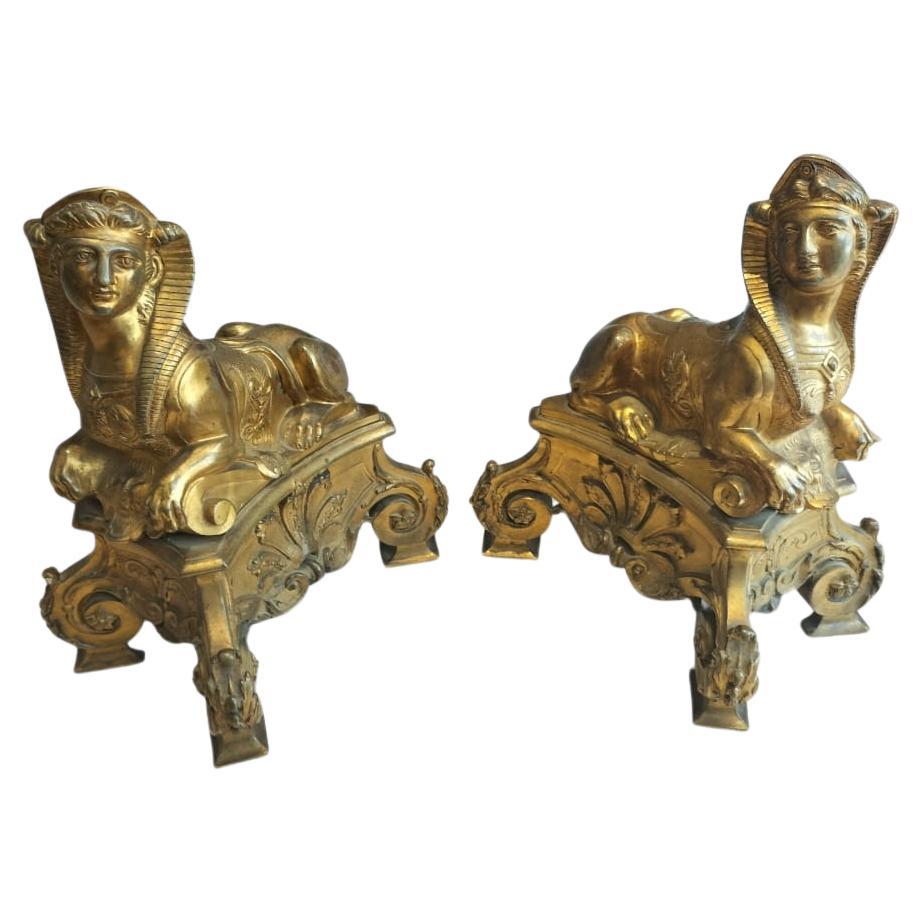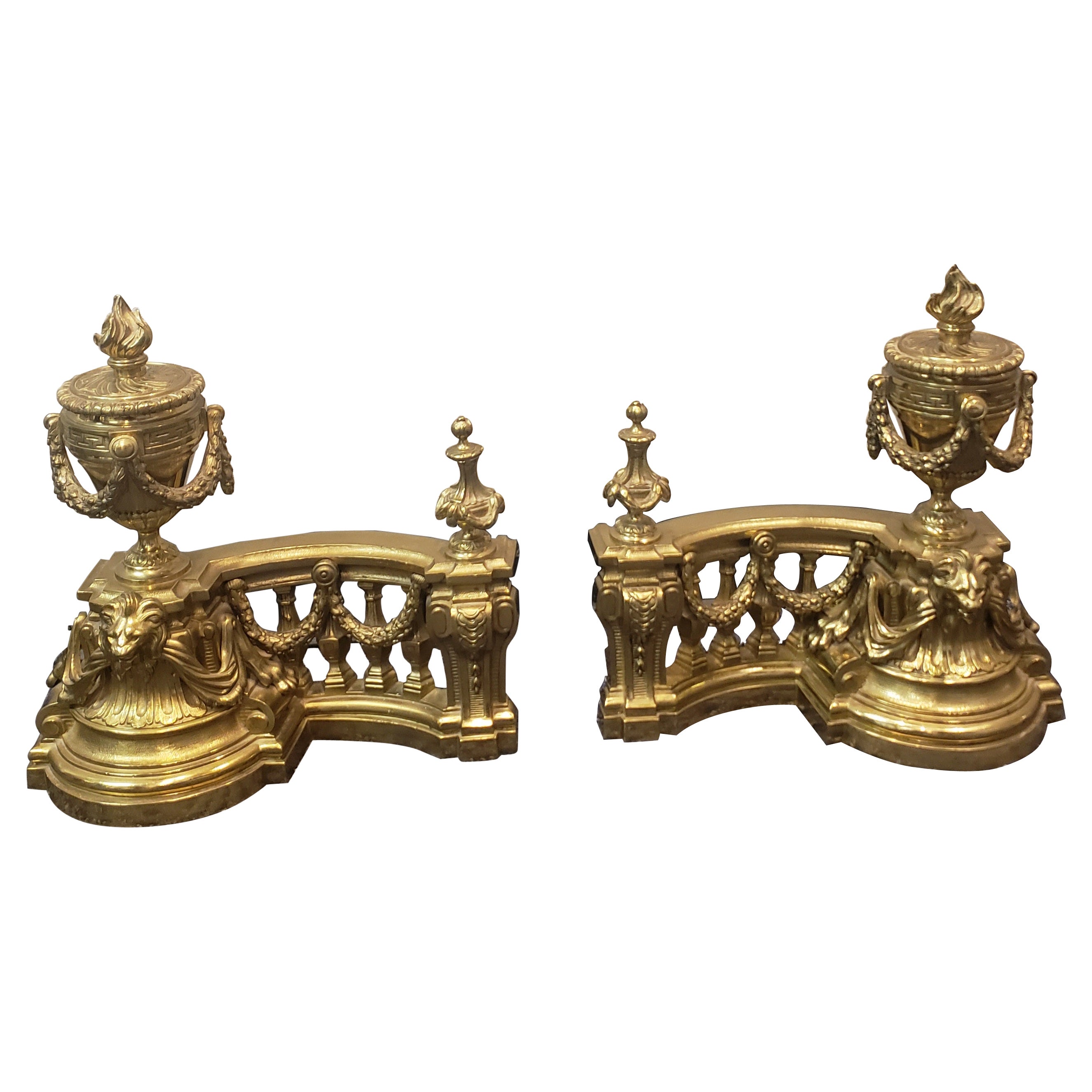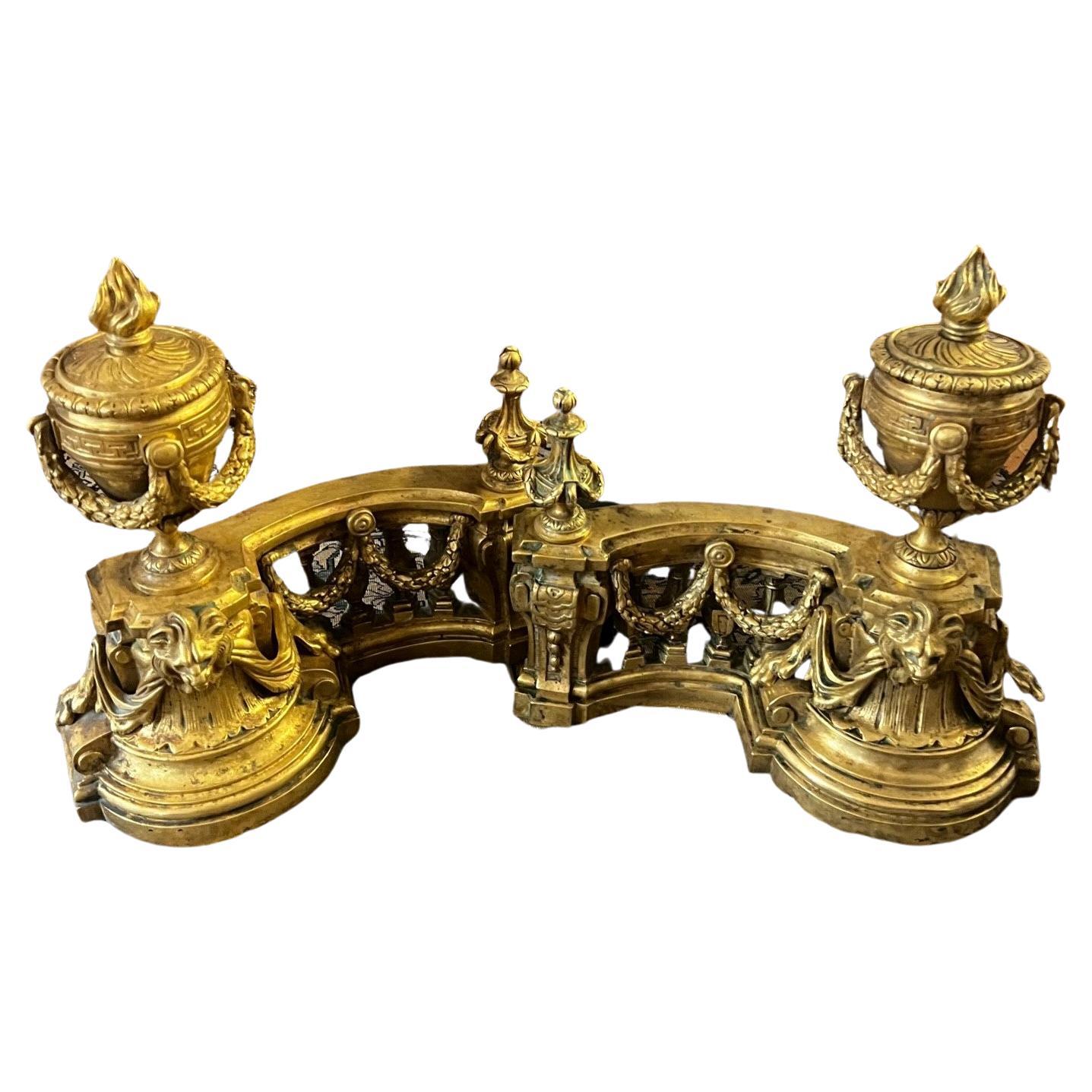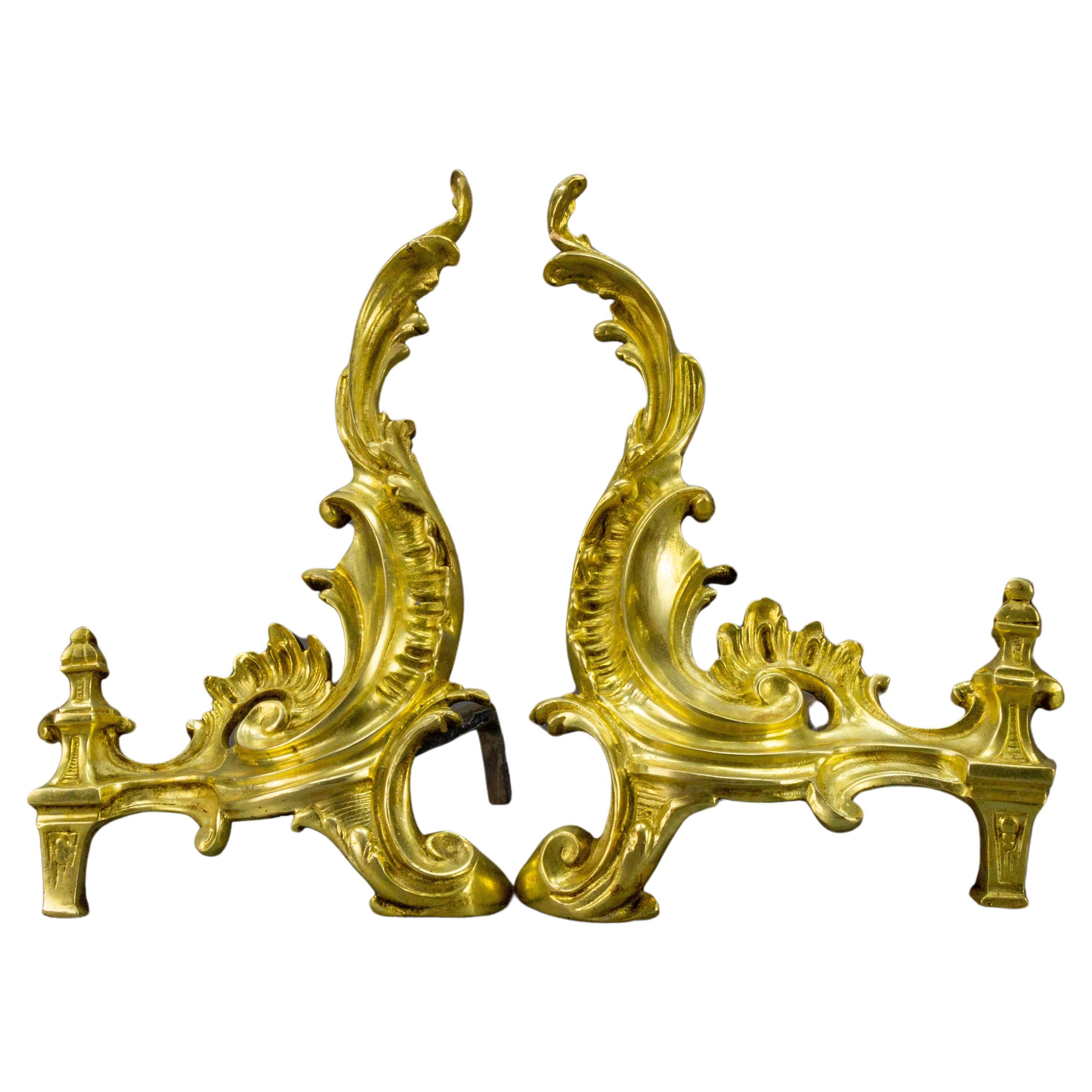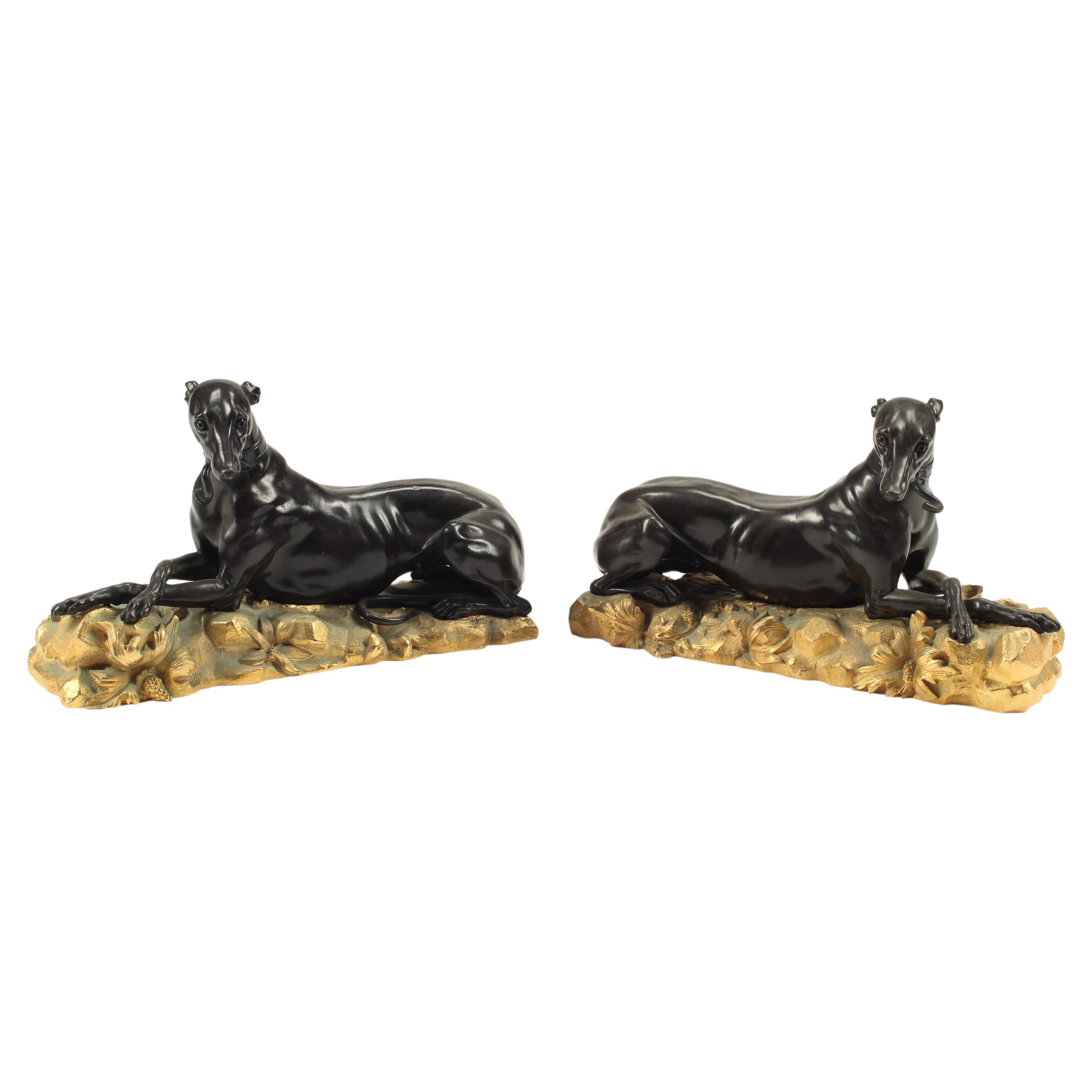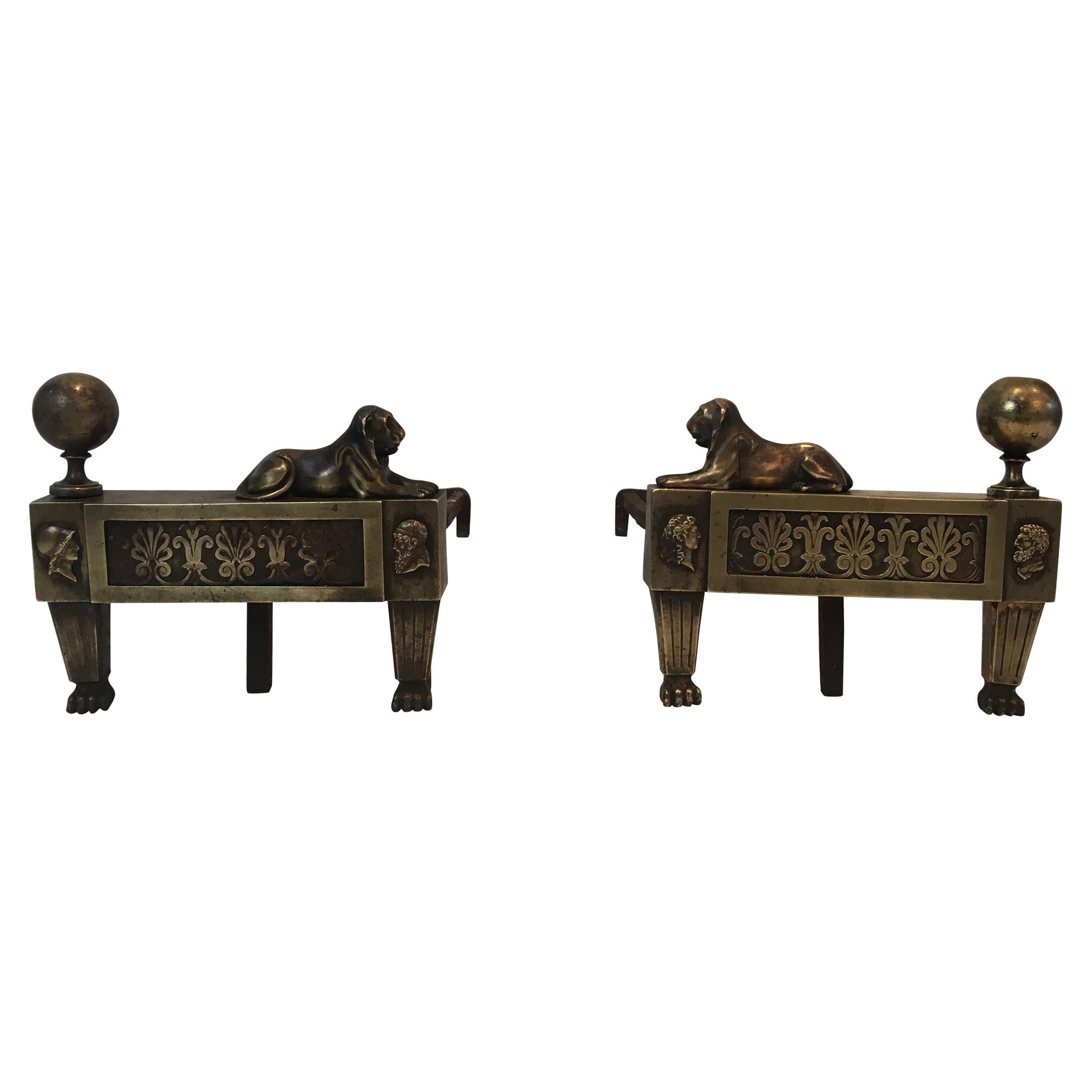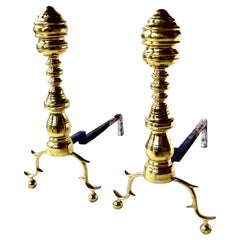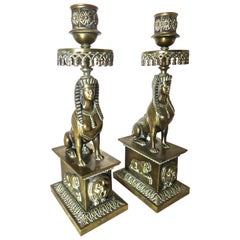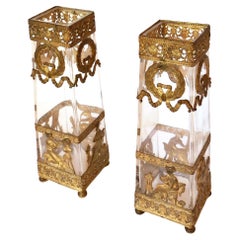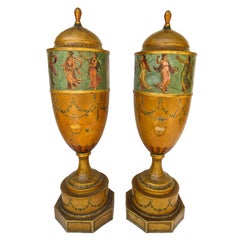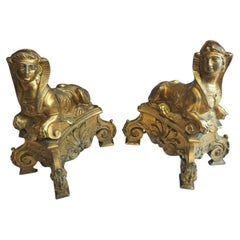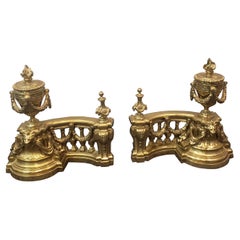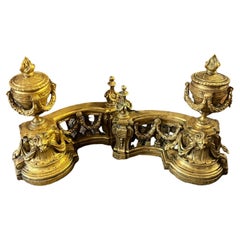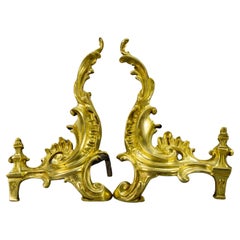Articoli simili a Pair of Gilt Bronze Regency Firedogs, Attributed To Thomas Hope. England Ca 1803
Vuoi altre immagini o video?
Richiedi altre immagini o video al venditore
1 di 21
Pair of Gilt Bronze Regency Firedogs, Attributed To Thomas Hope. England Ca 1803
39.199,24 €
Informazioni sull’articolo
These firedogs (as they were referred to), while not really serving any utility, would have been used as decoration to enhance the visual aesthetics of the hearth, by being placed one to each side of the fireplace opening. I have attached 20 images to this listing. The last image shows how they would have been used in a fireplace setting.
These highly ornate pair of gilt bronze firedogs are quite important and were, more than likely, the design of Thomas Hope (1769-1831), who created elaborate and innovative decorations whose features were influenced by his extensive travel through the Near East, Turkey, Egypt, Greece, and Europe, over a ten year period. He was the foremost interior designer during the Regency period and developed luxurious surroundings for his two lavish London residences during the early 19th century. They were decorated with items of his own design, along with those he had accumulated and collected during his travels. He introduced to the British aristocracy the term "interior design". In terms of collecting, and the acquisition of fine art and antiques, and generating wealth and real estate holdings, Thomas Hope was the early 19th century English rendition of William Randolph Hearst and J.P. Morgan 100 years later in America.
A study of "Household Furniture and Interior Decoration" written in 1807 by Thomas Hope, shows that he liked decorative, gilt bronze because he thought it brightened up a room. In the French tradition, he especially liked to combine dark patinated bronze figures with gilt bronze, especially with chimney mount pieces and fireplace accessories. This was evident by the extensive decor on display at his house on Duchess Street, London.
Egyptian influence was further inspired by his purchase in 1801 of what became known as "The Hope Lion"; a sculpted porphyry recumbent lion, thought to be a 2000 year old Egyptian artifact (see image). As in the artifact, the lions on these bronze firedogs also have a very slight green tint to the body.
This pair of firedogs could well have been cast by his "in house" bronze maker from France, Alexis Decaix; well known in his own right for his quality workmanship. The identical recumbent lion was also used in an 1802 design on a settee, and used as the cover plate of the book "Thomas Hope Regency Designer" published in 2008 by David Watkin, who has spent much of his life in the study of the man (see image). The same settee with lion is also referenced and sketched by Thomas Hope in his "Household Furniture" written in 1807, Plate VIII.
The firedogs measure: 13 3/4" long x 3" wide x 9 3/4" high. They are in exceptional original condition. They represent the style and decor of the Regency period and the elegant design of Thomas Hope, establishing them as a one of a kind, stand alone, early 19th century fireplace accessory.
The interest in Thomas Hope, the "Regency Designer" is still recognized today, and his influence continues to inspire decorators, designers, and collectors alike, because of his innovative, yet classic design.
Note: In the early 19th century Thomas Hope's brother, Henry Philip, acquired the famous "Hope Diamond" for the sum of $65,000, a high price to pay at that time. It remained in the family until 1902.
Provenance: From my own personal antiquarian collection
Note: I am a second generation antiques dealer and have been in business for 50 years; I am also a member of several prestigious antique associations. Thus, I am well qualified to inspect and evaluate the products I offer for sale and I guarantee them to be authentic and as I have described.
- Attribuito a:Thomas Hope (Designer)
- Dimensioni:Altezza: 24,77 cm (9,75 in)Larghezza: 7,62 cm (3 in)Profondità: 34,93 cm (13,75 in)
- Stile:Regency (Del periodo)
- Materiali e tecniche:
- Luogo di origine:
- Periodo:
- Data di produzione:circa 1803
- Condizioni:
- Località del venditore:Incline Village, NV
- Numero di riferimento:1stDibs: LU973210158433
Informazioni sul venditore
5,0
Venditore riconosciuto
Questi venditori prestigiosi sono leader del settore e rappresentano il massimo in termini di qualità e design.
Venditore Platino
Venditori Premium con valutazione 4.7+ e tempi di risposta entro 24 ore
Fondazione nel 1976
Venditore 1stDibs dal 2013
285 vendite su 1stDibs
Tempo di risposta standard: 2 ore
Associazioni
Art Dealers Association of America
- SpedizioneRecupero del preventivo…Spedizione da: Incline Village, NV
- Politica di reso
Alcune parti di questa pagina sono state tradotte automaticamente. 1stDibs non può garantire che le traduzioni siano corrette. L’inglese è la lingua predefinita del sito.
Garanzia di autenticità
Nell’improbabile caso in cui si verifichi un problema con l’autenticità di un articolo, contattaci entro un anno per ottenere un rimborso completo. DettagliGaranzia di rimborso
Se il tuo articolo non corrisponde alla descrizione, è danneggiato durante il trasporto o non arriva, contattaci entro 7 giorni per un rimborso completo. DettagliAnnullamento entro 24 ore
Hai un periodo di tolleranza di 24 ore per annullare il tuo acquisto, senza necessità di fornire spiegazioni.Venditori professionali selezionati
I nostri venditori di livello internazionale devono aderire a rigorosi standard di servizio e qualità, garantendo l’integrità delle inserzioni.Garanzia miglior prezzo
Se scopri che un venditore ha pubblicato altrove lo stesso articolo a un prezzo più basso, applicheremo lo stesso prezzo.Consegna globale affidabile
La nostra rete di vettori leader del settore offre opzioni di spedizione specializzate in tutto il mondo, inclusa la consegna personalizzata.Altro da questo venditore
Mostra tuttoCoppia di androni in ottone per caminetto del primo periodo vittoriano. Americano, circa 1850
Questa coppia di candelabri classici vittoriani in ottone massiccio ha una bella superficie originale, con un audace design verticale tornito e a bulbo sul palo, collegato in basso a...
Categoria
Di antiquariato/d’epoca, Anni 1850, Americano, Vittoriano, Alari
Materiali
Ottone, Ferro
Coppia di portacandele Regency con motivi egiziani di George Penton, inglese, circa 1808
Di George Penton
Rara coppia di portacandele in bronzo della Reggenza provenienti dal laboratorio londinese di George Penton in New Street Fetter Lane. An He era molto conosciuto e riconosciuto dagli...
Categoria
Di antiquariato/d’epoca, Inizio Ottocento, Inglese, Regency, Candelieri
Materiali
Bronzo
39.199 €
Spedizione gratuita
XIX sec. Coppia di vasi dorati altamente decorati francesi CIRCA 1875.
Coppia di cristalli del XIX secolo, rettangolari, affusolati verso l'alto, molto dorati e ornati da fusioni, repousse e applicazioni; decorazione tridimensionale di origine francese,...
Categoria
Di antiquariato/d’epoca, Anni 1870, Francese, Belle Époque, Vasi
Materiali
Cristallo, Similoro
Coppia di urne del XIX secolo "Tolo e rame giapponesizzato".
Le coperture a cupola in rame sono montate con terminali in legno (eventualmente aggiunti in un secondo momento). Il corpo sagomato delle urne termina con socie tornite che a loro vo...
Categoria
Di antiquariato/d’epoca, Inizio XIX secolo, Inglese, Regency, Urne
Materiali
Rame
Coppia di secchi in ottone di Giorgio III; 1 torba e 1 piatto, inglese
Coppia di sedie georgiane inglesi secchi rilegati in ottone, 1770 circa. I secchi sono ben fatti, robusti e in ottime condizioni, completamente originali e intatti. Questi bei secch...
Categoria
Di antiquariato/d’epoca, Anni 1770, Inglese, Giorgio III, Ciotole decora...
Materiali
Ottone
10.888 € / articolo
Coppia di candelabri a due luci in vetro tagliato e metallo dorato della Reggenza, circa 1815
Di origine britannica, circa 1815, e dal design Regency, il supporto a piattaforma in bronzo, con piedi a staffa ornati da teste di fiori e fogliame, sotto un collare di foglie, sost...
Categoria
Di antiquariato/d’epoca, XIX secolo, Inglese, Regency, Portacandele
Materiali
Bronzo
Ti potrebbe interessare anche
Coppia di cani da tiro in bronzo dorato del XIX secolo in stile antico egiziano
I candelabri del periodo della Reggenza francese, realizzati in bronzo dorato, mostrano una straordinaria miscela di eleganza e opulenza nello stile del revival egiziano. Ogni andron...
Categoria
Di antiquariato/d’epoca, XIX secolo, Francese, Regency, Accessori per ca...
Materiali
Bronzo
Coppia di cani da tiro in bronzo dorato dell'Antique French del XVIII secolo
Per te questa meravigliosa coppia di chenet / ciminiere francesi in bronzo dorato del XVIII secolo. I cani da tiro sono eccezionali e magistralmente realizzati in bronzo intagliato e...
Categoria
Di antiquariato/d’epoca, Fine XVIII secolo, Francese, Barocco, Accessori...
Materiali
Bronzo
Coppia di cani da tiro in bronzo dorato dell'Antique French del XVIII secolo
Questa meravigliosa coppia di chenet francesi in bronzo dorato del XVIII secolo. I cani da tiro sono eccezionali e magistralmente realizzati in bronzo intagliato e dorato, con elemen...
Categoria
Di antiquariato/d’epoca, Fine XVIII secolo, Francese, Barocco, Accessori...
Materiali
Bronzo
4930 € / set
Spedizione gratuita
Coppia di cani da tiro in ferro e bronzo dorato in stile French Rococo, inizio XX secolo
Una coppia di antichi getti d'aria in stile Luigi XV o rococò in bronzo dorato e ferro, Francia, circa anni '10 del XX secolo.
Questi meravigliosi fuochi o androni presentano una co...
Categoria
Inizio XX secolo, Francese, Luigi XV, Accessori per camino e comignoli
Materiali
Bronzo, Ferro
Coppia di Chenet in ormolu e bronzo patinato, XIX secolo, Francia
Una favolosa coppia di chenet (androni) francesi del XIX secolo con levrieri fusi in bronzo patinato su basi in ormolu. I levrieri sono delicatamente scolpiti per guardarsi l'un l'al...
Categoria
Di antiquariato/d’epoca, XIX secolo, Francese, Sculture di animali
Materiali
Bronzo
Coppia di androni in bronzo del periodo Impero con leoni, Francia, circa 1850
Questi candelabri sono realizzati in bronzo con leoni distesi faccia a faccia. Si tratta di una coppia di candelabri per caminetto del periodo Impero francese, risalenti al 1850 circa.
Categoria
Di antiquariato/d’epoca, Anni 1850, Francese, Stile impero, Accessori pe...
Materiali
Bronzo
